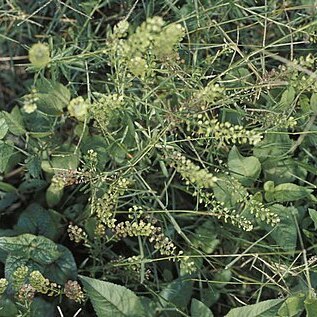Perennial. Stems erect, branching above, finely and closely grooved, glabrous or densely puberulent, (10)-15-50-(90) cm tall. Lvs all simple, hairy beneath or glabrous. Basal and lower stem lvs withering at fruiting, simple, toothed, lanceolate to oblanceolate, acute, (2)-3-10 × 1-2 cm, cuneately narrowed into a slender petiole. Upper lvs becoming linear or narrow-lanceolate, sessile, entire or toothed at apex or 3-fid, (5)-10-20-(30) × 1-3 mm. Racemes 5-10-(15) cm long at fruiting; rachis sparingly hairy or glabrous, ridged; pedicels erecto-patent, curved, 2-3 mm long at fruiting, with a single row of hairs. Sepals glabrous or sparsely hairy, purplish or green, 0.6-1 × 0.5 mm. Petals 0 or up to 1/2 length of sepals, white. Stamens 2. Silicle elliptic, 2-3 × 1.8-2.2 mm; stigma almost sessile, < or = the very shallow notch; valves purple or green, glabrous. Seed narrow-ovoid, brown, not winged, 1.2-1.5 mm long.
Annual or perennial herb to 70 cm high, erect. Leaves broadly to narrowly lanceolate, acute, serrate to entire, to 8 cm long, sparsely ciliate, the base attenuate, lnflorescence a dense elongated raceme. Sepals to 0.75 mm long. Petals reduced, thread-like, shorter than sepals. Stamens 2, median. Stigma subsessile. Silicula dehiscent, ovate to obovate 2–3 mm long, 1.5–2 mm wide, wings slight in upper half, forming shallow notch approximately one-tenth length of fruit; pedicels shorter than silicula, puberulous on adaxial surface, somewhat flattened, typically arcuate. Seeds c. 1.25 mm long; radicle incumbent.

